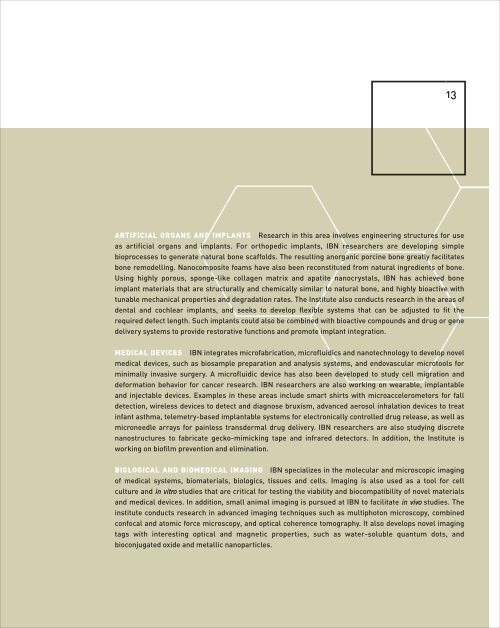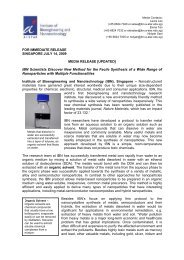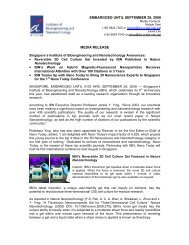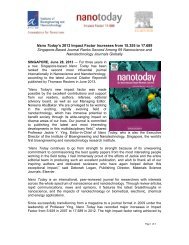IBN - Institute of Bioengineering and Nanotechnology - A*Star
IBN - Institute of Bioengineering and Nanotechnology - A*Star
IBN - Institute of Bioengineering and Nanotechnology - A*Star
Create successful ePaper yourself
Turn your PDF publications into a flip-book with our unique Google optimized e-Paper software.
13ARTIFICIAL ORGANS AND IMPLANTS Research in this area involves engineering structures for useas artificial organs <strong>and</strong> implants. For orthopedic implants, <strong>IBN</strong> researchers are developing simplebioprocesses to generate natural bone scaffolds. The resulting anorganic porcine bone greatly facilitatesbone remodelling. Nanocomposite foams have also been reconstituted from natural ingredients <strong>of</strong> bone.Using highly porous, sponge-like collagen matrix <strong>and</strong> apatite nanocrystals, <strong>IBN</strong> has achieved boneimplant materials that are structurally <strong>and</strong> chemically similar to natural bone, <strong>and</strong> highly bioactive withtunable mechanical properties <strong>and</strong> degradation rates. The <strong>Institute</strong> also conducts research in the areas <strong>of</strong>dental <strong>and</strong> cochlear implants, <strong>and</strong> seeks to develop flexible systems that can be adjusted to fit therequired defect length. Such implants could also be combined with bioactive compounds <strong>and</strong> drug or genedelivery systems to provide restorative functions <strong>and</strong> promote implant integration.MEDICAL DEVICES <strong>IBN</strong> integrates micr<strong>of</strong>abrication, micr<strong>of</strong>luidics <strong>and</strong> nanotechnology to develop novelmedical devices, such as biosample preparation <strong>and</strong> analysis systems, <strong>and</strong> endovascular microtools forminimally invasive surgery. A micr<strong>of</strong>luidic device has also been developed to study cell migration <strong>and</strong>deformation behavior for cancer research. <strong>IBN</strong> researchers are also working on wearable, implantable<strong>and</strong> injectable devices. Examples in these areas include smart shirts with microaccelerometers for falldetection, wireless devices to detect <strong>and</strong> diagnose bruxism, advanced aerosol inhalation devices to treatinfant asthma, telemetry-based implantable systems for electronically controlled drug release, as well asmicroneedle arrays for painless transdermal drug delivery. <strong>IBN</strong> researchers are also studying discretenanostructures to fabricate gecko-mimicking tape <strong>and</strong> infrared detectors. In addition, the <strong>Institute</strong> isworking on bi<strong>of</strong>ilm prevention <strong>and</strong> elimination.BIOLOGICAL AND BIOMEDICAL IMAGING <strong>IBN</strong> specializes in the molecular <strong>and</strong> microscopic imaging<strong>of</strong> medical systems, biomaterials, biologics, tissues <strong>and</strong> cells. Imaging is also used as a tool for cellculture <strong>and</strong> in vitro studies that are critical for testing the viability <strong>and</strong> biocompatibility <strong>of</strong> novel materials<strong>and</strong> medical devices. In addition, small animal imaging is pursued at <strong>IBN</strong> to facilitate in vivo studies. Theinstitute conducts research in advanced imaging techniques such as multiphoton microscopy, combinedconfocal <strong>and</strong> atomic force microscopy, <strong>and</strong> optical coherence tomography. It also develops novel imagingtags with interesting optical <strong>and</strong> magnetic properties, such as water-soluble quantum dots, <strong>and</strong>bioconjugated oxide <strong>and</strong> metallic nanoparticles.
















